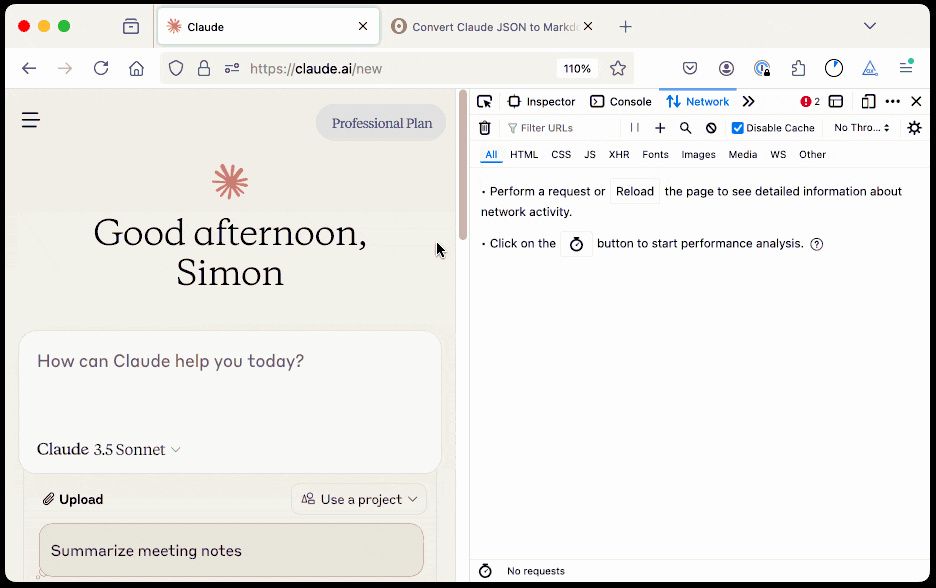Blogmarks tagged observable, projects in 2024
Filters: Type: blogmark × Year: 2024 × observable × projects × Sorted by date
Share Claude conversations by converting their JSON to Markdown. Anthropic's Claude is missing one key feature that I really appreciate in ChatGPT: the ability to create a public link to a full conversation transcript. You can publish individual artifacts from Claude, but I often find myself wanting to publish the whole conversation.
Before ChatGPT added that feature I solved it myself with this ChatGPT JSON transcript to Markdown Observable notebook. Today I built the same thing for Claude.
Here's how to use it:

The key is to load a Claude conversation on their website with your browser DevTools network panel open and then filter URLs for chat_. You can use the Copy -> Response right click menu option to get the JSON for that conversation, then paste it into that new Observable notebook to get a Markdown transcript.
I like sharing these by pasting them into a "secret" Gist - that way they won't be indexed by search engines (adding more AI generated slop to the world) but can still be shared with people who have the link.
Here's an example transcript from this morning. I started by asking Claude:
I want to breed spiders in my house to get rid of all of the flies. What spider would you recommend?
When it suggested that this was a bad idea because it might attract pests, I asked:
What are the pests might they attract? I really like possums
It told me that possums are attracted by food waste, but "deliberately attracting them to your home isn't recommended" - so I said:
Thank you for the tips on attracting possums to my house. I will get right on that! [...] Once I have attracted all of those possums, what other animals might be attracted as a result? Do you think I might get a mountain lion?
It emphasized how bad an idea that would be and said "This would be extremely dangerous and is a serious public safety risk.", so I said:
OK. I took your advice and everything has gone wrong: I am now hiding inside my house from the several mountain lions stalking my backyard, which is full of possums
Claude has quite a preachy tone when you ask it for advice on things that are clearly a bad idea, which makes winding it up with increasingly ludicrous questions a lot of fun.
Hacker News homepage with links to comments ordered by most recent first (via) Conversations on Hacker News are displayed as a tree, which can make it difficult to spot new comments added since the last time you viewed the thread.
There's a workaround for this using the Hacker News Algolia Search interface: search for story:STORYID, select "comments" and the result will be a list of comments sorted by most recent first.
I got fed up of doing this manually so I built a quick tool in an Observable Notebook that documents the hack, provides a UI for pasting in a Hacker News URL to get back that search interface link and also shows the most recent items on the homepage with links to their most recently added comments.
See also my How to read Hacker News threads with most recent comments first TIL from last year.
Ham radio general exam question pool as JSON. I scraped a pass of my Ham radio general exam this morning. One of the tools I used to help me pass was a Datasette instance with all 429 questions from the official question pool. I've published that raw data as JSON on GitHub, which I converted from the official question pool document using an Observable notebook.
Relevant TIL: How I studied for my Ham radio general exam.
Wrap text at specified width. New Observable notebook. I built this with the help of Claude 3 Opus—it’s a text wrapping tool which lets you set the width and also lets you optionally add a four space indent.
The four space indent is handy for posting on forums such as Hacker News that treat a four space indent as a code block.
GitHub Public repo history tool (via) I built this Observable Notebook to run queries against the GH Archive (via ClickHouse) to try to answer questions about repository history—in particular, were they ever made public as opposed to private in the past.
It works by combining together PublicEvent event (moments when a private repo was made public) with the most recent PushEvent event for each of a user’s repositories.